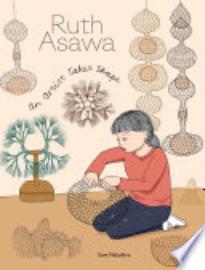Nakahira, Sam
1 Reviews
(2)
4-6
This graphic-format biography of Japanese American artist Asawa (1926 2013) begins on December 7, 1941, as teenage Ruth and her farming family hear that Japan has attacked Pearl Harbor. Soon the FBI arrests her father ("They think he's dangerous? He can't even kill a chicken for dinner"), and the rest of the family are sent to Santa Anita Racetrack, where they must sleep in horse stables. But luckily for Ruth, interned Disney animators are teaching drawing classes. "Everything was gray until I met the cartoonists...Truly, art saved me." After the family is sent to the Rohwer Relocation Center in Arkansas, Ruth receives a college scholarship. She studies art education in Milwaukee -- then isn't allowed to graduate; the war has ended, but prejudice hasn't. At the experimental Black Mountain College in North Carolina, Ruth thrives and begins working on the wire sculptures for which she becomes so well known. A theme throughout is Ruth's sheer determination -- to not become a farmer; to study art; to marry the white man she loved despite their families' disapproval, to have children ("I want six") and still be an artist. Gratifyingly, the book closes with her doing just that. Nakahira's black-and-white illustrations, clear and direct, allow viewers to see both the helplessness and courage of those who were forcibly incarcerated. The art is also ideal for illuminating the lines, shapes, and empty spaces of Asawa's famous wire sculptures. Appended are further biographical information, a reading list, and photos of the artist and her work.
Reviewer: Jennifer M. Brabander
| Horn Book Magazine Issue:
May, 2024
1 reviews
We are currently offering this content for free. Sign up now to activate your personal profile, where you can save articles for future viewing.




